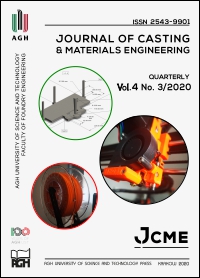Polylactide Used as Filment in 3D Printing – Part 1: FTIR, DRIFT and TG-DTG Studies
DOI:
https://doi.org/10.7494/jcme.2020.4.3.48Abstract
A short literature review was undertaken in terms of the structure, properties and applications of polymers, including those commonly used in 3D printing. The research part included the structural and thermal analysis of polylactide (PLA), which is an example of an extensively used polymer in the developing 3D technology. Special attention was paid to the comparison of structure and thermal stability of two different (from various producers) polylactide samples. The research, involving such analytical methods as infrared spectroscopy (FTIR) and diffuse reflectance infrared spectroscopy (DRIFT), allowed the comparison of the structure of the two PLA samples considered. The determination of the temperature range in which changes related to PLA thermodestruction occur was a result of the performed thermoanalytical research (DRIFT, TG-DTG). Thermal studies also allowed to establish the temperature range in which the material does not yet degrade, which is important in the context of future planned research work on polylactide modification to obtain the improvement of the thermal and mechanical properties of PLA-based materials. This research area will be described in the second part of the publication.
Downloads
References
Kaziunas France A. (2014). Świat druku 3D. Przewodnik. Gliwice: Wydawnictwo Helion.
Dodziuk H. (2019). Druk 3D/AM. Zastosowania oraz skutki społeczne i gospodarcze. Warszawa: Wydawnictwo Naukowe PWN.
Dikova T., Dzhendov D., Bliznakova K. & Ivanov D. (2016). Application of 3D printing in manufacturing of cast patterns.
VIIth International Metallurgical Congress, 9–12 June 2016, Ohrid, Macedonia.
Manas C. & Salil R. (2008). Industrial polymers, specialty polymers and their applications. Boca Raton, USA: CRC Press.
Syrek H. (2013). Zastosowanie drukarek 3D do wytwarzania modeli woskowych w procesie odlewania metodą traconego wosku. Nafta-Gaz, 69(12), 929–935.
Przybytek A., Kucińska-Lipka J. & Janik H. (2016). Thermoplastic elastomer filaments and their application in 3D printing. Elastomery, 20(4), 32–39.
Sasimowski E. (2015). Przyrostowe metody wytwarzania elementów z tworzyw polimerowych. Przetwórstwo Tworzyw, 21(4), 349–354.
Sarecka-Hujar B., Ostróżka-Cieślik A. & Banyś A. (2016). Innowacyjne technologie w medycynie i farmacji. Acta Bio-Optica et Informatica Medica. Inżynieria Biomedyczna, 22(1), 9–17.
Lee V., Singh G., Trasatti J.P., Bjornsson C., Xu X., Tran T.N., Yoo S.S.,
Dai G. & Karande P. (2014). Design and fabrication of human skin by three-dimensional bioprinting. Tissue Engineering: Part C:
Methods, 20(6), 473–484. Doi: 10.1089/ten.TEC.2013.0335.
Kusaka M., Sugimoto M., Fukami N., Sasaki H., Takenaka M., Anraku T., Ito T., Kenmochi T., Shiroki R. & Hoshinga K. (2015). Initial experience with a tailor-made simulation and navigation program using a 3-D printer model of kidney transplantation surgery. Transplantation Proceedings, 47(3), 596–599. Doi: 10.1016/j.transproceed.2014.12.045.
Florjańczyk Z. & Penczek S. (1995). Chemia polimerów, Vol. 1: Makrocząsteczki i metody ich otrzymywania. Warszawa: Oficyna Wydawnicza Politechniki Warszawskiej.
Rabek J.F. (2008). Współczesna wiedza o polimerach. Warszawa: Wydawnictwo Naukowe PWN.
Woźna A. (2012). Struktura kompozytów bioresorbowalnych wytworzonych z zastosowaniem generatywnej metody laserowej. Modelowanie Inżynierskie, 14(45), 134–138.
Poh P.S.P., Chhaya M.P., Wunner F.M., De-Juan-Pardo E.M., Schilling A.F., Schantz J.T., van Griensven M. & Hutmacher D.W. (2016). Polylactides in additive biomanufacturing. Advanced Drug Delivery Reviews, 107, 228–246.
Chhaya M.P., Melchels F.P.W., Holzapfel B.M., Baldwin J.G. & Hutmacher D.W. (2015). Sustained regeneration of high-volume adipose tissue for breast reconstruction using computer aided design and biomanufacturing. Biomaterials, 52, 551–560.
Thapsukhon B., Thadavirul N., Supaphol P., Meepowpan P., Mol-
loy R. & Punyodom W. (2013). Effects of copolymer microstructure on the properties of electrospun poly(L-lactide-co-ε-caprolactone) absorbable nerve guide tubes. Journal of Applied Polymer Science, 130(6), 4357–4366.
Simpson R.L., Wiria F.E., Amis A.A., Chua C.K., Leong K.F., Hansen U.N., Chandrasekaran M. & Lee M.W. (2008). Development of a 95/5 poly(L-lactide-co-glycolide)/hydroxylapatite and β-tricalcium phosphate scaffold as bone replacement material via selective laser sintering. Journal of Biomedical Materials Research Part B: Applied Biomaterials, 84B(1), 17–25.
Downloads
Published
Issue
Section
How to Cite
Accepted 2020-09-09
Published 2020-09-30



